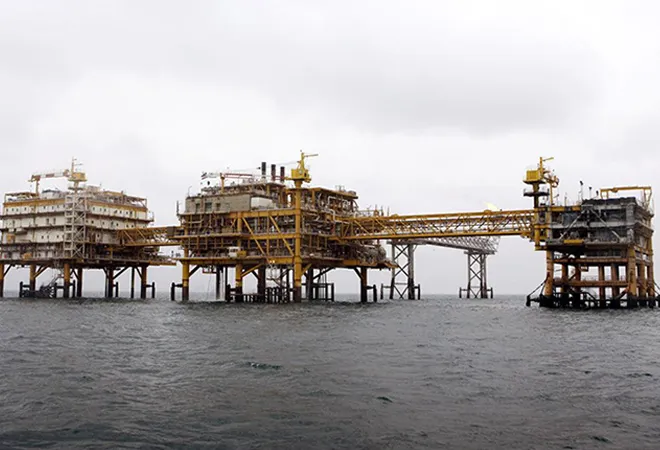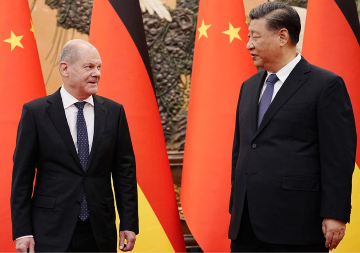
Following the May 2018 US decision to withdraw from the JCPOA, it has reimposed extensive sanctions to check Iran’s lucrative energy sector. Most of these measures are primary sanctions, and comprise of asset freezes, trade embargoes and prohibition on US citizens and companies from engaging with Iran. However, some of these measures impose “extra territorial” or “secondary” sanctions, i.e., penalise third-country firms that are involved in Iran’s energy sector. These can potentially penalise Indian companies with exposure to US financial institutions, and prohibit loans from US financial entities. There are two pathways through which Indian institutions could be affected by such secondary sanctions.
First, investments by companies (both US and foreign-based) to the tune of at least USD 20 million in one year in Iran’s energy sector can trigger sanctions under the Iran and Libya Sanctions Act (ILSA, P.L. 104-172) and the Comprehensive Iran Sanctions, Accountability, and Divestment Act (CISADA, P.L. 112-158). <1> The term “investment” is defined widely and includes responsibility for development of petroleum resources, equity and royalty arrangements, additions to existing investments, pipelines, and construction, upgrading and expansion of energy projects. <2>
Presently, India has planned several oil and gas development projects, and pipeline projects in Iran. India is interested in developing two Iranian natural gas fields, namely, the Farzad-B gas field (located in Tehran) <3> and the South Pars field (shared between Iran and Qatar). It is believed that the proposed investment for these projects could run into billions of dollars, with estimates for Farzad-B gas field placed at around USD 6.2 billion which clearly crosses the USD 20-million investment threshold. <4> Similarly, Indian investments towards the Iran-Pakistan-India pipeline (IPI) and the Middle East to India Deep Water pipeline (MEIDW) stand to be affected due to the re-imposition of sanctions.
India is interested in developing two Iranian natural gas fields, namely, the Farzad-B gas field (located in Tehran) and the South Pars field (shared between Iran and Qatar).
Second, US sanctions also target the purchase of Iranian crude oil. Though no direct sanctions have been imposed on such purchases, the US requires measures on mechanisms that importers use to pay for oil from Iran. Executive Order 13622 and Section 1245 of the National Defense Authorization Act (NDAA, P.L. 112-81) impose sanctions on foreign banks that have processed crude oil transactions, by restricting activities on their existing US accounts and prohibiting the opening of new accounts. <5> The principal mechanism through which the US seeks to achieve this objective is by preventing foreign banks from dealing with the Central Bank of Iran (CBI) when it comes to making petroleum payments. <6>
Currently, several Indian private and public sector companies purchase crude oil from Iran. <7> The payment pathway that Indian refiners use to pay for Iranian crude is the following. Indian companies pay the State Bank of India (SBI) that then transfers the funds in euros to the Europaisch-Iransische Handlesbank (EIH) in Germany that, in turn, transfers the funds to Iran’s National Iranian Oil Company. <8> While the EIH is on the Office of Foreign Assets Control (OFAC) database, <9> it was removed from the secondary sanctions list following the JCPOA <10> which allowed non-US entities (such as the SBI) to use it as a conduit to do business with Iran. Following the US pull-out from the JCPOA, the EIH will be put back on it, with the consequence that the SBI will not be able to use EIH to transfer Indian funds to Iran. It goes without saying that other formal banking mechanisms to pay for Iranian oil will also face similar difficulties. For example, an Iranian account in Indian rupees with, say, the SBI will expose that bank to direct US secondary sanctions.
In addition to these JCPOA-related re-impositions, the recently-enacted Countering America’s Adversaries Through Sanctions Act (CAATSA), through Title I, imposes sanctions to specifically target Iran’s support for terrorism-related activities, WMD and ballistic missiles programme. (It is important to note that CAATSA was passed into law before the US decision to withdraw from JCPOA.) Under Section 105 of CAATSA, the main target for US sanctions is the Islamic Revolutionary Guard Corps (IRGC). <11> The IRGC has been subject to sanctions before, under provisions of six Executive orders. <12>
However, there are three main differences between the previous IRGC sanctions and the newly enacted CAATSA provisions. The most pertinent among these is the fact that CAATSA also empowers the administration to extend these sanctions to any “foreign persons” that are deemed as “officials, agents, or affiliates” of the IRGC. <13> The extension of sanctions to such “foreign persons,” especially companies or entities, could amount to secondary sanctions. While the conditions for determining “foreign persons” have not been provided under any legislation or executive order, generally, designated individuals and entities have been known to act for or on behalf of, or provide support to the IRGC. However, the absence of a definition of what constitutes a foreign official, agent or entity of the IRGC gives great flexibility to the US administration to make these determinations.
There are three main differences between the previous IRGC sanctions and the newly enacted CAATSA provisions. The most pertinent among these is the fact that CAATSA also empowers the administration to extend these sanctions to any “foreign persons” that are deemed as “officials, agents, or affiliates” of the IRGC.
One potential Indian entity that could come under the crosshairs of Section 105 of CAATSA is the Indian Ports Global Private Limited (IPGPL) — a state-owned joint venture of the Jawaharlal Nehru Port Trust and the Kandla Port Trust. In May 2016, IPGPL and an Iranian company, Arya Banader, signed a bilateral contract to develop and run the Chabahar port. <14> (For background on this port, see the chapter by Kriti Mathur Shah in this report.) Arya Banader does not figure in the OFAC database, so IPGPL seems to not have run afoul of any US regulations.
However, in December 2017, news reports emerged that suggested that that project was contracted to Khatam al-Anbia (KaA), an IRGC-affiliated entity that is subject to stringent sanctions. Notably, OFAC notes that doing business with KaA will attract secondary sanctions. <15> These news reports also noted that one of the subcontractors of KaA was an (unnamed) “state-run Indian company.” <16> One presumes — given that IPGPL was specifically tasked with the development of Chabahar port — that this unnamed company is either IPGPL or a special-purpose vehicle created by it. It remains unknown how this Indian company, as a KaA subcontractor, has avoided secondary sanctions. Whatever the case may be, with the new provisions of CAATSA Section 105 — and its unspecified definition of “foreign affiliates” — Indian firms involved in the development of Chabahar port (which seems to be managed in significant parts by IRGC-controlled entities) would have to tread cautiously so as to not be designated as such.
This essay originally appeared in ORF Special Report Beyond JCPOA: Examining the consequences of US withdrawal.
References
<1> Initially, the ISA sanctions applied to U.S. companies only. However, the CISADA extended the application of these sanctions to non-U.S. based companies. See, “Frequently Asked Questions (FAQs) regarding Enforcement against Foreign Persons of U.S. Trade Sanctions against Iran”, Notice No. 10 2013/2014, West of England, last modified May, 2013.
<2> Kenneth Katzman, Iran Sanctions, (Washington D.C.: Congressional Research Service, 2018), 11.
<3> “ONGC Videsh offers to invest $6.2 bn in Iran's giant Farzad-B gas field”, Business Standard, February 14, 2018.
<4> “Iran agrees to take OVL’s Farzad-B gas”, The Hindu, April 10, 2018.
<5> Katzman, Iran Sanctions, 21.
<6> Ibid.
<7> Debjit Chakraborty and Dhwani Pandya, “Iran said to cut benefits on crude oil sales to Indian state-run refiners”, Economic Times Energy World, April 9, 2017.
<8> “German bank to process payments for India,” January 5, 2011, rediff.com; Nidhi Verma, “SBI to stop handling Iran oil payments, imports may be hit,” Reuters, June 15, 2018.
<9> “OFAC Sanctions List Search: EUROPAISCH-IRANISCHE HANDELSBANK AG ,” Office of Foreign Assets Control, US Department of Treasury.
<10> “JCPOA-related Designation Removals, JCPOA Designation Updates, Foreign Sanctions Evaders Removals, NS-ISA List Removals; 13599 List Changes,” Office of Foreign Assets Control, US Department of Treasury, January 16, 2016.
<11> Countering America’s Adversaries through Sanctions Act of 2017, Pub. L. No. 115-44, 84 Stat. 1114 (2017).
<12> “OFAC FAQs: Iran Sanctions”, U.S. Department of the Treasury, accessed 20 June, 2018.
<13> Countering America’s Adversaries through Sanctions Act of 2017, Pub. L. No. 115-44, 84 Stat. 1114 (2017).
<14> “List of Agreements/MOUs signed during the visit of Prime Minister to Iran,” Ministry of External Affairs, Government of India, May 23, 2016.
<15> “OFAC Sanctions List Search: Khatam al-Anbia,” Office of Foreign Assets Control, US Department of Treasury, accessed June 21, 2018.
<16> “Iran inaugurates new extension to its main Arabian Sea port,” LiveMint, December 3, 2017.
The views expressed above belong to the author(s). ORF research and analyses now available on Telegram! Click here to access our curated content — blogs, longforms and interviews.




 PREV
PREV


